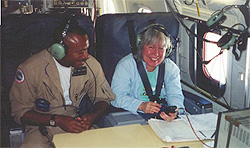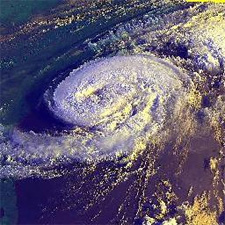Features
Flying Through Hurricanes with Robbie Hood
05.06.04
| Who are NASA's Earth Explorers? The elementary school student wondering how El Niño will affect tomorrow's weather. The scientist studying connections between ozone and climate change. And the farmer using satellite pictures to keep track of crops. All of these people are Earth Explorers -- they are all curious about the Earth system. This monthly series will introduce you to NASA Earth Explorers, young and old, with many backgrounds and interests. |
Most people's eyes would be glued to the window -- or tightly shut -- when flying through a hurricane. Instead, Robbie Hood stares mostly at her computer monitor.

|
Image to right: Robbie Hood and crew member Mark Corlew on a NASA DC-8 aircraft used to fly into hurricanes
Credit: NASA
"The view out of the aircraft windows can be somewhat boring," said Hood, who served as lead scientist on two of NASA's hurricane-probing CAMEX (Convection And Moisture Experiment) missions. "The aircraft is often flying through clouds so there is not much to see."
There is plenty to look at on her laptop, however, which displays a continuous stream of real-time atmospheric data being collected by an array of instruments and sensors outside the aircraft. The goal is to use the data to improve understanding and prediction of hurricanes.
Specifically, Hood is interested in how rainfall intensity affects overall storm strength. (When water vapor condenses into rain, energy is released to the surrounding air.) The research conducted by Hood and her colleagues helps models more accurately predict a hurricane's track, strength at landfall and potential for inland flooding. Improved forecasts could eliminate unnecessary coastal evacuations while increasing the warning time for those in harm's way.
But why send an airplane into the middle of a hurricane when there are satellites that can make observations from space? Hood says that the aircraft data, when combined with satellite information, gives scientists a more detailed, three-dimensional view of how hurricanes work. Measurements taken from inside the storm are also used to verify the accuracy of the satellite data.
"We're putting the storm under a microscope," said Hood, who is joined at about 40,000 feet up by other scientists, engineers, and the pilot and crew. "You can see the storm structures in higher detail (than from satellites alone)."

|
"The variety of cloud layers and types can be quite impressive," Hood said. "It's like seeing every cloud you could imagine all in one place."
Image to left: Hurricane Bonnie, seen here from the NOAA-12 satellite, is one of several hurricanes Robbie Hood has flown through
Credit: NASA
Hood's fascination with weather and hurricanes goes back to her days growing up in the South. Raised on a cattle farm in Missouri, she became very familiar with the economic impact weather can have on agriculture. Hood's family also happened to be in Mississippi when, in 1969, Hurricane Camille slammed into the Gulf Coast.
"To see the kind of damage that it could do made a big impression on me," said Hood, who remembers the storm knocking out power, downing trees, and blowing the roofs off of houses.
Their severity is not the only thing that sparks Hood's interest in hurricanes. She is also attracted by the human qualities assigned to, and taken on by, the storms. In fact, Hood has always been a bit of a people person.
"I credit my Native American heritage with my intense interest and appreciation of people," said Hood, who is a member of the western tribe of the Cherokee nation. "I think I like studying hurricanes because they act so much like people. Hurricanes have names and personalities and don't behave like we expect them to sometimes."
See previous Earth Explorers articles:
+ Read more
Coming in June: Meet the scientists from NASA's upcoming Aura mission.
Related Resources
Event-Based Science: Hurricane! Remote Sensing Activities
http://www.mcps.k12.md.us/departments/eventscience/EBS.EOS.HU.html
Hurricane Bonnie lithograph
http://eospso.gsfc.nasa.gov:16080/ftp_docs/Hurricane_Bonnie.pdf
Institute for Global Environmental Strategies